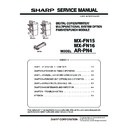Sharp MX-RB15 (serv.man11) Service Manual ▷ View online
2-56
CHAPTER 2 FINISHER UNIT BASIC OPERATION
III. POWER SUPPLY SYSTEM
1.
Outline
The finisher controller PCB is supplied with 24 VDC power when the host machine is turned
on. Power is also supplied from the finisher controller PCB to the saddle stitch controller PCB. In
addition, power is also supplied to the punch driver PCB when the optional puncher unit is mounted.
addition, power is also supplied to the punch driver PCB when the optional puncher unit is mounted.
Some of the 24 VDC power used to drive motors is cut off when the Finisher Safety Switch1
(FSSW1) is open. The power to the saddle stitch controller PCB, however, will not be cut off.
Figure 2-301 is a block diagram showing the power supply system.
Power source
Finisher Safety Switch1
(FSSW1)
Figure 2-301
2.
Protection Functions
The 24 VDC power line used to drive motors and solenoids is equipped with a circuit breaker
(CB1) for protection against overcurrent. The 24 V line used to drive the Finisher Paper Transport
Motor2 (FPTM2), Finisher Paper Alignment Motor (FPAM), and Finisher Stapler Shift Motor
(FSSM) are equipped with a fuse, which is designed to blow when an overcurrent occurs.
Motor2 (FPTM2), Finisher Paper Alignment Motor (FPAM), and Finisher Stapler Shift Motor
(FSSM) are equipped with a fuse, which is designed to blow when an overcurrent occurs.
CHAPTER 3
SADDLE STITCH UNIT
BASIC OPERATION
I.
BASIC OPERATION .................... 3-1
A. Outline ....................................... 3-1
B. Electrical Circuitry ...................... 3-2
C. Inputs to and Outputs from the
B. Electrical Circuitry ...................... 3-2
C. Inputs to and Outputs from the
Saddle Stitch Controller PCB ..... 3-3
II.
FEEDING/DRIVE SYSTEM ......... 3-8
A. Outline ....................................... 3-8
III. PAPER OUTPUT
MECHANISM ............................. 3-14
A. Outline ..................................... 3-14
B. Controlling the Inlet
B. Controlling the Inlet
Flappers ................................... 3-17
C. Controlling the Movement of
Sheets ...................................... 3-21
D. Aligning the Sheets .................. 3-23
E. Controlling the Phase of the
E. Controlling the Phase of the
Crescent Roller ........................ 3-26
IV. STITCHING SYSTEM ............... 3-28
V.
FOLDING/DELIVERY
SYSTEM .................................... 3-31
SYSTEM .................................... 3-31
VI. CHECKING FOR A JAM ........... 3-38
VII. POWER SUPPLY ...................... 3-43
VII. POWER SUPPLY ...................... 3-43
1. This chapter discusses the purpose and role of each of the saddle stitch functions, and the
principles of operation used for the stitch mechanical and electrical systems. It also explains
the timing at which these systems are operated.
the timing at which these systems are operated.
The
symbol in drawings indicates transmission of mechanical drive, and signals marked
by
together with the signal name indicates the flow of electrical signals.
2. In descriptions of digital circuits on the stitch, “1” indicates a high signal voltage level, while
“0” indicates a low signal voltage level. Voltage values differ according to circuit.
A microprocessor is used on the stitch. A description of microprocessor operation is omitted in
this chapter as it is practically impossible to check internal operation of the microprocessor.
this chapter as it is practically impossible to check internal operation of the microprocessor.
Descriptions in this chapter also assume that PCBs will not be repaired at user sites. For this
reason, descriptions of circuits on PCBs is limited to block diagrams. Two types of block dia-
grams are provided for separate functions: diagrams indicating details from sensors up to input
sections of major PCBs, and diagrams indicating details from the output sections of major
PCBs up the loads.
reason, descriptions of circuits on PCBs is limited to block diagrams. Two types of block dia-
grams are provided for separate functions: diagrams indicating details from sensors up to input
sections of major PCBs, and diagrams indicating details from the output sections of major
PCBs up the loads.
3-1
CHAPTER 3 SADDLE STITCH UNIT BASIC OPERATION
I.
BASIC OPERATION
A.
Outline
The unit “stitches” (2 points) a stack of sheets delivered by the finisher unit and folds it in two
for delivery. All these operations are controlled by the saddle stitch controller PCB in response to
commands from the host machine via the finisher unit.
commands from the host machine via the finisher unit.
Finisher unit control system
Control system
Guide plate drive system
Paper positioning plate
drive system
Alignment drive system
Saddle stitch drive system
Delivery drive system
Feed drive system
Paper pushing plate
drive system
Paper folding roller
drive system
Figure 3-101
3-2
CHAPTER 3 SADDLE STITCH UNIT BASIC OPERATION
B.
Electrical Circuitry
The sequence of operations used for the saddle stitch is controlled by the saddle stitch control-
ler PCB. The saddle stitch controller PCB has a microprocessor. This microprocessor is used to
control the sequence of operations and to handle serial communications with the finisher controller
PCB, driving solenoids and motors in response to the various commands from the finisher control-
ler PCB.
control the sequence of operations and to handle serial communications with the finisher controller
PCB, driving solenoids and motors in response to the various commands from the finisher control-
ler PCB.
The saddle stitch controller PCB is also used to communicate the state of various sensors and
switches to the finisher controller PCB in serial.
The functions of the major ICs mounted on the saddle stitch controller PCB are as follows:
●
Q1
Controls the sequence of operations.
Controls the sequence of operations.
●
Q2
Contains the sequence program.
Contains the sequence program.
●
Q3
Controls the sequence of operations.
Controls the sequence of operations.
●
Q4
Handles IPC communications.
Handles IPC communications.
Electrical circuitry block diagram
Sensors
Switches
Q1 CPU
Q2
ROM
Q3
RAM
Q4
Communi-
cations IC
Saddle stitch
controller PCB
Motors
Solenoids
Host machine
Finisher controller
PCB
Figure 3-102
Click on the first or last page to see other MX-RB15 (serv.man11) service manuals if exist.

